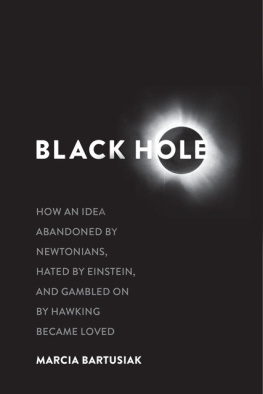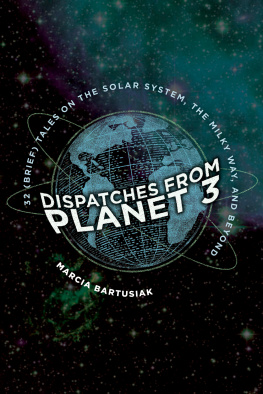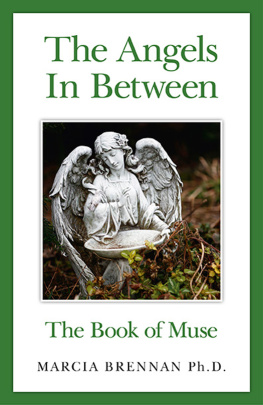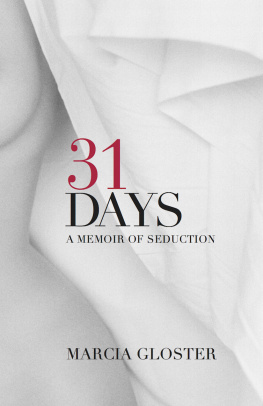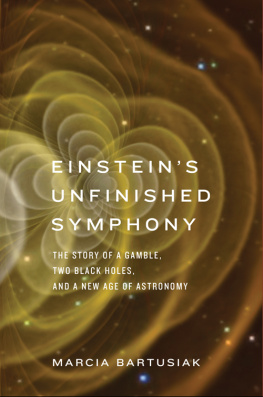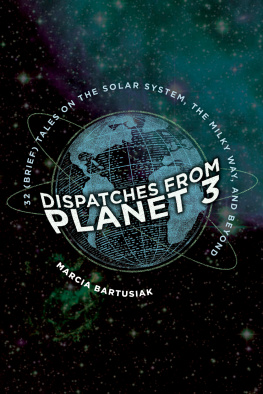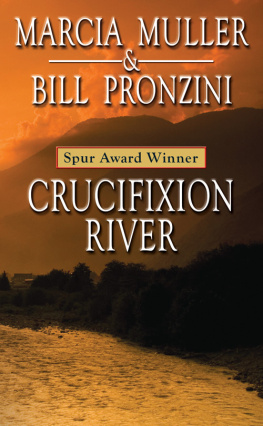Marcia Bartusiak - The Day We Found the Universe
Here you can read online Marcia Bartusiak - The Day We Found the Universe full text of the book (entire story) in english for free. Download pdf and epub, get meaning, cover and reviews about this ebook. year: 2009, publisher: Pantheon Books, genre: Non-fiction. Description of the work, (preface) as well as reviews are available. Best literature library LitArk.com created for fans of good reading and offers a wide selection of genres:
Romance novel
Science fiction
Adventure
Detective
Science
History
Home and family
Prose
Art
Politics
Computer
Non-fiction
Religion
Business
Children
Humor
Choose a favorite category and find really read worthwhile books. Enjoy immersion in the world of imagination, feel the emotions of the characters or learn something new for yourself, make an fascinating discovery.

- Book:The Day We Found the Universe
- Author:
- Publisher:Pantheon Books
- Genre:
- Year:2009
- Rating:4 / 5
- Favourites:Add to favourites
- Your mark:
- 80
- 1
- 2
- 3
- 4
- 5
The Day We Found the Universe: summary, description and annotation
We offer to read an annotation, description, summary or preface (depends on what the author of the book "The Day We Found the Universe" wrote himself). If you haven't found the necessary information about the book — write in the comments, we will try to find it.
Marcia Bartusiak: author's other books
Who wrote The Day We Found the Universe? Find out the surname, the name of the author of the book and a list of all author's works by series.
The Day We Found the Universe — read online for free the complete book (whole text) full work
Below is the text of the book, divided by pages. System saving the place of the last page read, allows you to conveniently read the book "The Day We Found the Universe" online for free, without having to search again every time where you left off. Put a bookmark, and you can go to the page where you finished reading at any time.
Font size:
Interval:
Bookmark:

ALSO BY MARCIA BARTUSIAK
Thursday's Universe
Through a Universe Darkly
Einstein's Unfinished Symphony
Archives of the Universe
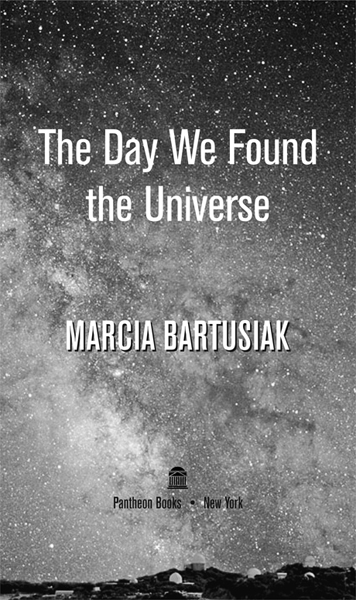
To Steve
The center of my universe, who shared
every light-year along the way
16.
T he twenties were not just roaring, they were blazing.
Moviegoers were flocking to the cinema to watch in amazement as Moses parted the Red Sea in Cecil B. DeMille's silent film epic The Ten Commandments, Greece overthrew its monarchy and proclaimed itself a republic, the first dinosaur eggs were discovered in Mongolia's Gobi Desert, and crossword puzzles became all the rage. It was the height of the Jazz Age, when Victorian ideals came tumbling down in a frenzy of flappers, Freudian analysis, and abstract art. While majestic ocean liners crossed the Atlantic in under five days, Clarence Birdseye introduced the public to the novelty of frozen food and a failed artist named Adolf Hitler published Mein Kampf. It was a world, wrote F. Scott Fitzgerald in his classic novel The Great Gatsby, redolent of orchids and pleasant, cheerful snobbery and orchestras which set the rhythm of the year, summing up the sadness and suggestiveness of life in new tunes.
It was also an era of immense scientific fervor. On December 30, 1924, some four thousand scientists descended upon Washington, D.C., to attend the annual conference of the American Association for the Advancement of Science. Taking advantage of the three-day gathering, the American Astronomical Society held its meeting in the capital at the same time, with nearly eighty astronomers attending from across the United States. They lodged at the Powhatan, a plush eight-story hotel located on the corner of Eighteenth Street and Pennsylvania Avenue, where a room with private bath cost $2.50 a night and weary travelers could relax in its rooftop garden. Two blocks away Calvin Coolidge opened the doors of the White House to the visiting AAAS members. While notorious for being a man of few words, the thirtieth president of the United States was uncharacteristically chatty the day of the reception. It has taken endless ages to create in men the courage that will accept the truth simply because it is the truth, Coolidge told his guests. We have advanced so far that we do not fear the results of that process. We ask no recantations from honesty and candor Those of us who represent social organization and political institutions look upon you with a feeling that includes much of awe and something of fear as we ask ourselves to what revolution you will next require us to adapt our scheme of human relations. Six months later high school biology teacher John Scopes would go on trial in Tennessee for illegally teaching Charles Darwin's theory of evolution.
The astronomers, though, were scarcely aware that Washington was host to the largest number of scientists ever assembled for an AAAS meeting. Their interest was intently focused on the astronomy program, which included talks on the atmosphere of Mars, how fast celestial objects could move, the temperature of Mercury, and the latest computed orbit of the eclipsing double-star system Algol.
On Wednesday, the second day of the meeting, the astronomers were taken by glass-topped buses to the U.S. Naval Observatory, in the northwest sector of the town, for a tour of the facility and a buffet luncheon in its stately main hall. Later that evening, New Year's Eve, occurred an event which was marked on the program and celebrated by a number of the faithful, Popular Astronomy recounted. As the clock struck twelve, astronomers happily changed to civil reckoning for determining the start of a day. No longer would the astronomical day begin at high noon, a tradition launched in the days of Ptolemy that often led to great bookkeeping confusion. Instead, it now began at midnight, just as it did for everyone else. It will probably be remembered and noted long after other astronomical happenings of the current year are forgotten, stated the magazine.
But a presentation made on Thursday, New Year's Day, ultimately overshadowed all other events at the meeting. Looking out their hotel windows that inaugural morning of 1925, convention-goers discovered a blanket of snow covering the city, enough to give holiday sleds a good tryout, reported the Washington Post. Despite the ongoing snowstorm, however, the astronomers kept to their schedule and walked the short distance to the newly constructed Corcoran Hall, on the nearby campus of George Washington University, for a joint session with the mathematicians and physicists of the AAAS. They first heard a talk on stellar evolution, followed by a lecture posing the question Is the Universe Infinite? which led to a lively discussion among the conferees. Then right before the noon break, a paper modestly titled Cepheids in Spiral Nebulae was presented to the assembled audience. Those not familiar with astronomy likely imagined it was a minor technical work, of interest only to a specialist. But the astronomers in the room immediately grasped its significance. For them, it was electrifying news. Despite its lackluster title, this paper was no less than the culmination of a centuries-long quest to understand the true nature and extent of the cosmos. January 1, 1925, was the day that astronomers were officially informed of the universe's discovery.
The author of the paper was thirty-five-year-old Edwin Hubble, a staff astronomer at the Mount Wilson Observatory, in southern California. Hubble had aimed Mount Wilson's 100-inch reflector, the largest telescope in its day, toward a pair of celestial clouds known as Andromeda and Triangulum, the only spiral nebulae in the nighttime sky that can be seen with the naked eye. By having access to significant telescopic power, Hubble was at last able to resolve individual stars in the outer regions of the two mistlike clouds, and to his surprise and delight some turned out to be Cepheids, special stars that methodically dim and brighten as if they were slow-blinking cosmic stoplights.
The signals revealed that our galaxy, the Milky Way, was not alone. The Cepheids were telling Hubble that the Andromeda and Triangulum nebulae were very distant, situated far beyond our galactic borders. Our celestial home was suddenly humbled, becoming just one of a multitude of galaxies residing in the vast gulfs of space. In one fell swoop, the visible universe was enlarged by an inconceivable factor, eventually trillions of times over. In more familiar terms, it's as if we had been confined to one square yard of Earth's surface, only to suddenly realize that there were now vast oceans and continents, cities and villages, mountains and deserts, previously unexplored and unanticipated beyond that single plug of sod. Hubble directed our eyes to billions of other galaxiesother Milky Ways formerly unknownscattered like separate atoms through space and time, as far outward as telescopes could peer. Indications of the Milky Way's true place in the universe had been cropping up for years, but the evidence was indirect, conflicting, and controversial. Hubble stepped into the fray and finally provided the decisive proof. He confirmed an idea to everyone's satisfaction that beforehand had been on far shakier ground.
It was the astronomical news of the century and yet Hubble, astonishingly, was not presentat this, his moment of triumph. Instead, the staid and respected Princeton University astronomer Henry Norris Russell stood in for Hubble that morning and relayed his findings to the conferees. From all accounts, Hubble was neither sick nor detained by family matters. He might have been put off by the long and wearying cross-country train ride, but the reason for his absence was possibly more idiosyncratic. Hubble, a former legal scholar trained in weighing evidence, was concerned that by the time of the astronomy meeting he hadn't countered every feasible argument against his finding. At his own observatory, in fact, a colleague had gathered the strongest ammunition against his conclusion, evidence Hubble couldn't yet refute. This loose end bothered him immensely. What Hubble craved was an airtight caseno stone unturned, no question left unansweredbefore stepping up to the podium himself. Being caught in a scientific error was Hubble's greatest nightmare. Back in California the young astronomer was fretfully asking himself, Could I possibly be wrong?
Font size:
Interval:
Bookmark:
Similar books «The Day We Found the Universe»
Look at similar books to The Day We Found the Universe. We have selected literature similar in name and meaning in the hope of providing readers with more options to find new, interesting, not yet read works.
Discussion, reviews of the book The Day We Found the Universe and just readers' own opinions. Leave your comments, write what you think about the work, its meaning or the main characters. Specify what exactly you liked and what you didn't like, and why you think so.

